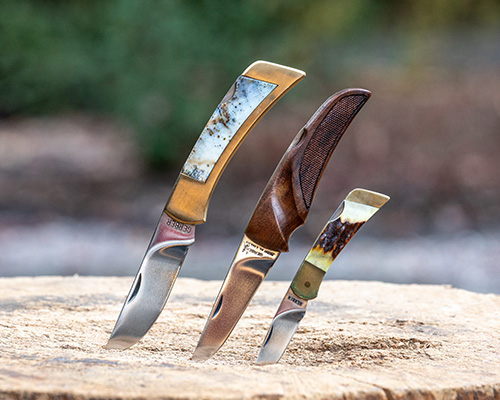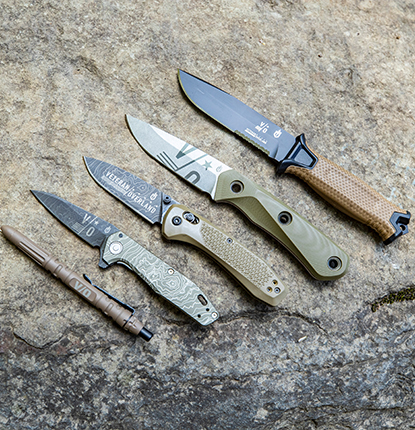As summer’s long days grow shorter and the fall chill gets ever closer, our minds turn to one thing: Hunting. While we may not have embarked as a hunting brand, you can’t tell our story without talking about our Gerber hunting knives. As we’ve stated in another article, Gerber initially made carving and kitchen knives, but one letter from a man in Montana introduced the world of hunting knives.
As you’ll come to see, we have a long history with hunters, including using their insights to help shape our designs. Plenty of hunters are walking the halls of Gerber HQ, all equally as passionate about knives as they are chasing game. Join us as we prepare for the upcoming hunting season, and tag along to learn about the history of Gerber hunting knives.
The First Hunting Knives

In 1947, Gerber made their first hunting knife, The AF Hunter—a large hunting knife made exclusively for Abercrombie & Fitch. But bigger expansion into the hunting space came by request. One day in 1948, a letter came across Joe Gerber’s desk and eventually led to the production of the Shorty.
This excerpt from A History of Gerber Sport Knives by Bernard Levine tells the whole story in detail.
“In the spring of 1948 an outdoorsman named Hale Woolf in
Kalispell, Montana, contacted Gerber, praised their products, and
asked if they would make him a small hunting knife to their
standards, but to his design, which he enclosed as a sketch.
Gerber obliged with two prototypes, made and shipped in April.
Woolf liked them, and so did a lot of other people. Regular
production of this “Shorty” began in July.
The first ads, playing up this Montana connection for all it was worth, were
scheduled to break in August, in publications all over the West.
Success came quickly for the Shorty, but it soon became
obvious that upscale small-town jewelers were not the ideal
retailers to sell working hunting knives. Ham Gerber proceeded
to set up a second and largely separate network of dealers, which
he called simply “Shorty dealers.” Typically this would be a
town’s best sporting goods or gun shop, if the town had one.
Otherwise, it would be whichever hardware or general merchant in a town carried the best brands of guns and fishing tackle.
Some cutlery specialty stores were allowed to stock both of the Gerber
lines — the gift-boxed Legendary Blades, as well as the Shorty.
Meanwhile, the larger Gerber A. & F. Hunter was still sold
exclusively by Abercrombie & Fitch.
Shorty soon had other company, though. In June 1950 Gerber
introduced its second sheath knife for general distribution, the
Fisherman. This was nothing more than a Miming steak knife blade
with a shortened handle and offered with an optional fitted sheath. ”
The Shorty was just the start. As the decades moved on, more models hit the markets, and more hunters had their hands on these early sport knives.
BIG HUNTER AND ITS MANY NAMES
The original AF Hunter and the Shorty were still in circulation, but a few modifications and feedback led to the design change and the birth of the Big Hunter. By 1959, it was known as the Lamb Hunter, and in 1965, it was renamed again as the Magnum, and finally, in 1970, it was renamed the Magnum Hunter.
An important change happened to the handles during this era. During a project for a custom knife, they decided to start die casting the handles for more precision in the design. The combination of the die-cast, plus the classic chrome-plated Gerber handle, resulted in polished aluminum handles that would become a staple on almost every Gerber knife from then on out.
TWIN SETS
Once again, an avid outdoorsman came knocking on Gerber’s door again.
“Around 1954 a live-wire salesman and avid hunter named Jerry Beason began to represent the Gerber sport knife in Alaska. The firm did not exactly hire him. He just started sending in
wholesale orders (along with money) which Gerber had little
choice but to honor.
In the late 1950s or early 1960s, Beason began to send in
orders for combination sets, of a big knife and a little Pixie
riding piggy-back in a double sheath. Gerber did not make such a
product, but Beason was not a man one could say “No” to, so
Gerber began to make these sets for him and then added them to
the regular line. In 1966 they began to make combination sets
with a knife and a Sportsman’s Steel, also combined in a double sheath.”
THE HUNTING FOLDER

By 1966, Gerber was a big company and in a brand-new factory. Among all the growth changes was the first folding knife for the brand, the Coho fishing knife. This folder was the base for the series of folding hunting knives that would hit the market through the 1970’s. While it didn’t quite catch, the design for the first Folding Hunter was well ahead of its time. It had no rivets or any way to tell how it was assembled, making it a sleek and smooth design.
The switch to folding knives from big, fixed blade knives was a revolutionary start that we still take for granted in modern hunting knives today.
MODERN KNIVES
In more modern times, plenty of Gerber hunting knives have been a great success. Most notably, it would have to be the fan-favorite Gator series. Using a textured gator grip handle, this knife is one of the brand’s all-time best sellers.
In 2017, Gerber partnered with iconic backcountry hunter Randy Newberg to produce a series of hunting knives that had the insight of an expert hunter. His knives have unique features like the tendon cutter and improved jimping for control.
Today, our series of hunting knives contains everything you would need for hunting. From the lightweight EXO-Mod series for backcountry hunters to shears for bird hunters and the Downwind series for blind hunters, we have it all and are continuing to plan for future hunting knives with modern innovations.






